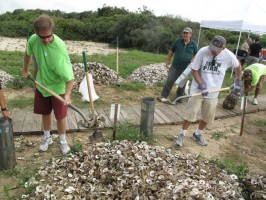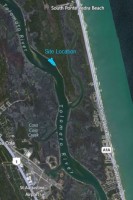
Just north of the Flagler-St. Johns County line there is a unique science project underway that drew my attention several weeks ago when I heard about it at a meeting of the GTM NERR Management Advisory Group, of which I am a member. While oysters aren’t high on my list of things to write about, an oyster restoration project changed all that.
 First, let me explain what GTM NERR is and how it fits into this column’s subject. In 1972 the federal government established the National Estuarine research Reserve System to protect a variety of coastal land and water areas for long-term research, water-quality monitoring, education and stewardship. In an interesting partnering of federal and state authorities, the National Oceanic and Atmospheric Administration (NOAA) provides funding, national guidance and technical assistance while state agencies or universities provide operational management.
First, let me explain what GTM NERR is and how it fits into this column’s subject. In 1972 the federal government established the National Estuarine research Reserve System to protect a variety of coastal land and water areas for long-term research, water-quality monitoring, education and stewardship. In an interesting partnering of federal and state authorities, the National Oceanic and Atmospheric Administration (NOAA) provides funding, national guidance and technical assistance while state agencies or universities provide operational management.
The Guana Tolomato Matanzas National Estuarine Research Reserve (GTM NERR) is just such a blending of NOAA and a state agency, in this case the Florida Department of Environmental Protection. The reserve is directed by its manager, Dr. Michael Shirley, and has a staff of administrators, researchers, and educators, who are located at the Environmental Education Center in Ponte Vedra Beach.

From its website, the Reserve “is dedicated to the conservation of natural biodiversity and cultural resources through research and monitoring to guide science-based stewardship and education strategies.” It protects 73,352 acres in St. Johns and Flagler counties, which provide habitat for at least 44 mammal, 358 bird, 41 reptile, 21 amphibian, 303 fish and 580 plant species. Its wildlife habitats are essential for 48 protected animals and eight protected plants. A further important fact is that 16 species in the Reserve are fished or harvested commercially, and 18 species are fished recreationally.
In other words, GTM NERR plays a critical role in the preservation of land and water areas of northeast Florida. One of 28 such Reserves in the United States, it also engages in extensive public education programs and conducts a wide variety of research projects. And this is where the oyster restoration project comes into focus.

At a quarterly meeting of the Management Advisory Group, comprised of both government representatives and citizen appointees (like me), Oyster Reef Project Coordinator Lauren Flynn described how she and volunteers are creating a man-made oyster reef using shucked oyster shells from local participating restaurants. Called the Community Oyster Shell Recycling and Living Reef Restoration Project, its objective is to restore a lost shoreline and lure oysters to rebuild oyster beds where they once thrived.
The project location. Click on the image for larger view.Oysters play an important role in the coastal marine system, plus they are an important seafood species. Oysters filter pollutants from the water, thereby helping to maintain water quality. Because of various natural and man-made factors, including coastal development, water pollution, and wave action from boat traffic, local oyster reefs have decreased significantly in size and number. Their disappearance along the southern portion of the Guana Peninsula (the barrier island north of St. Augustine) has created a kind of domino effect of environmental destruction allowing the breakdown of the salt marsh, which contributes to shoreline erosion and the diminishment of the upland habitat.
The GTM Research Reserve, in partnership with the non-profit Friends of the GTM Research Reserve and St. Johns Technical High School, are working with several local restaurants to obtain oyster shells, which are collected and bagged by volunteers. Lauren Flynn told me that the participating restaurants, among them Aunt Kate’s, Cap’s on the Water, Hurricane Patty’s, and Matanzas Inlet Restaurant, are pleased that their oyster shells are being “recycled” in this project, rather than simply ending up in landfills. Restaurant staffs are excited about their roles in the process and Lauren believes more restaurants will sign on as the project grows.
After collection the shells are placed in quarantine for 90 days to insure that no bacteria are allowed to enter the oyster reef system. The bags are then transported to the restoration area, where teams of volunteers carefully place them according to the plan drawn created by Lauren to maximize the success of the project. Beside restaurant employees and the students from St. Johns Technical School, other volunteers include citizens, both young and old, from St. Johns and Flagler Counties.
Lauren Flynn will manage and monitor this project, and report results periodically, which I will pass along in future columns. I enjoyed learning about the oyster reef restoration project and support efforts like this to preserve, protect and enhance our natural world. If this project interests readers, anyone seeking more information or willing to volunteer may contact Lauren by email or by phone (904/823-4500).
Until next time, be well and get involved in your part of the world to protect nature.
![]()
Frank Gromling is the owner of Ocean Publishing in Flagler Beach. Reach him by email here.





























Jim Neuenfeldt says
I think it would be a smart idea for the State of Florida to put a deposit on Oyster Shells.
They could put a deposit say of $1.00 per pound, on each bag which is numbered on the tag being sold to a restaurant or consumer. To return the Shells, you simply tag the now empty shells, and the origination tag back to a Oyster seller, and upon weighing the shells you are given back your deposit in full.
The tag portion is imperative to stop the theft of Shells that are already refunded and returned to the water.
This would not be a hard thing to do at all. The Oyster sellers themselves could implement this program which in effect keeps them in business for years to come.
It is the right thing to do!
MSFB says
Sorry Jim, but your talking about adding $50.00 to a bushel of oysters. That’s more that what the oysters cost!